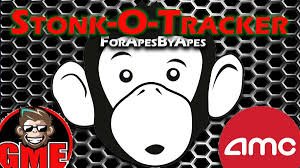Introduction To Stonk-O-Tracker
In the world of retail investing, few tools have gained as much attention as the Stonk-O-Tracker. Originally designed by an independent developer and quickly embraced by the online trading community, this platform has become a go-to resource for retail traders who follow heavily shorted stocks like AMC, GME, and BBBY. Its simple interface, real-time metrics, and community-driven appeal make it especially popular among those who want transparency in the often complex world of short selling and options trading.
The rise of meme stocks in 2021 turned everyday traders into analysts, and many realized the importance of accessible data that traditional financial services often hide behind paywalls. That is where Stonk-O-Tracker fits in—it acts as a public dashboard, making it easier to visualize information about short interest, options activity, borrowing availability, and more. This guide will explain how it works, what features it offers, and why it continues to matter for retail investors today.
How Stonk-O-Tracker Works
At its core, Stonk-O-Tracker is an aggregator. It pulls data from public and semi-public sources such as Interactive Brokers, the SEC, FINRA, Yahoo Finance, and ETF databases. By combining these feeds into one interface, it helps traders save time and gain clarity on stock conditions. Unlike premium platforms that require subscriptions, this tool is free to access and designed with simplicity in mind.
The data is updated frequently, though not always in real-time. For example, some short volume percentages may be updated daily, while borrowing availability and fee rates often come directly from Interactive Brokers snapshots. The developer behind the tracker has also been transparent about its limitations: because it relies on public sources, it may not capture every data point or reflect the full scope of market activity. Despite this, the platform has carved out a niche as one of the most trusted dashboards for meme-stock traders.
Key Features Of Stonk-O-Tracker
Short Interest Data
One of the most closely followed metrics on Stonk-O-Tracker is short interest. This shows how much of a stock’s trading volume is tied to short selling. A high short interest percentage often signals heavy bearish bets, which can lead to volatility or even a short squeeze if traders are forced to cover their positions. The tracker also displays Short Sale Restriction (SSR) triggers, which occur when a stock drops more than 10% in a single day. These triggers temporarily limit short selling activity, a detail that meme-stock traders follow closely.
Fails-To-Deliver (FTD) Reports
Another powerful feature is its Fails-to-Deliver (FTD) section. FTD occurs when a seller does not deliver shares within the required settlement time. Elevated FTD levels can sometimes indicate market manipulation or high pressure from short activity. By displaying these numbers, Stonk-O-Tracker helps traders spot irregularities that may not be obvious from price action alone.
Options Data: Calls & Puts
Options activity is also prominently displayed. The site breaks down open interest and tracks how many call and put contracts are “in the money.” For example, if a large number of call options are about to expire in the money, it can create upward price pressure due to hedging activity by market makers. Retail traders often analyze these charts to anticipate potential “gamma squeezes” where options dynamics influence stock price.
Borrowed Shares & Availability
Stonk-O-Tracker also tracks the number of shares available to borrow and the associated borrowing fees. This metric is crucial because when borrow availability is low and fees are high, it becomes more expensive for short sellers to maintain their positions. Traders view this as a potential setup for upward pressure on stock prices, especially when combined with rising retail demand.
ETF Exposure
Finally, the platform provides insights into ETF exposure. Many meme stocks are included in exchange-traded funds, which means broader market activity can indirectly affect their price. Stonk-O-Tracker breaks down which ETFs hold shares of stocks like GME or AMC, helping traders understand the bigger picture of market influence.
Why Retail Traders Use Stonk-O-Tracker
The popularity of Stonk-O-Tracker is not just about numbers—it’s about empowerment. Retail investors, who historically lacked access to institutional-grade data, now have a free tool that provides at least a partial view of what’s happening behind the scenes. Traders use it to track potential short squeezes, measure liquidity, and understand the mechanics driving their favorite meme stocks.
Another reason for its widespread adoption is community culture. On platforms like Reddit, traders often share screenshots from Stonk-O-Tracker as evidence for their market theories. It became more than just a tool; it became a rallying point for retail investors who wanted to challenge Wall Street narratives.
Advantages Of Stonk-O-Tracker
The primary advantage of Stonk-O-Tracker is accessibility. Unlike subscription-based platforms such as Ortex, it is free to use and does not require an account. Its interface is clean and easy to understand, which lowers the learning curve for new traders. Additionally, the focus on specific meme stocks means that users do not need to filter through endless tickers or irrelevant data—they can jump straight to the metrics that matter.
Another advantage is transparency. The developer has openly shared where the data comes from and acknowledged when certain sources stop providing updates. This honesty builds trust among retail investors, who often suspect manipulation from traditional market data services.
Limitations And Data Accuracy
Despite its usefulness, Stonk-O-Tracker is not perfect. One major limitation is that it relies heavily on Interactive Brokers for borrow data, which may not reflect the full market. If Interactive Brokers stops reporting, the site can appear “stuck” with outdated numbers. Additionally, not all ETF holdings or FTD reports are captured instantly, leading to occasional lags.
It is also important to recognize that this tool is best used as a supplementary resource, not the sole basis for investment decisions. Because it cannot guarantee 100% accuracy, traders should cross-check numbers with official filings and other financial platforms.
How To Read And Use Stonk-O-Tracker Effectively
To get the most out of Stonk-O-Tracker, traders should focus on trends rather than snapshots. A single day of high short interest or low borrow availability may not mean much, but consistent patterns over weeks can signal important shifts. Combining this with other indicators, such as volume and price action, makes for stronger analysis.
Additionally, pairing Stonk-O-Tracker data with outside tools such as Ortex or FINRA reports helps confirm findings. For options data, traders should understand expiration cycles and gamma exposure before drawing conclusions from the tracker’s charts. Used wisely, Stonk-O-Tracker can enhance decision-making without replacing due diligence.
Stonk-O-Tracker Vs Other Market Tools
When compared to professional tools like Bloomberg Terminal or Ortex, Stonk-O-Tracker is far less comprehensive. However, it excels in being free, accessible, and retail-focused. While Bloomberg provides global coverage of every ticker imaginable, most retail traders do not need that level of complexity. Instead, they want targeted information on meme stocks, which is exactly what Stonk-O-Tracker delivers.
The trade-off is accuracy and breadth. Paid platforms may offer more precise data, but the appeal of Stonk-O-Tracker lies in its grassroots, community-driven approach. For many retail investors, it is the perfect complement to official filings and professional data services.
Community Role And Social Buzz
The social dimension of Stonk-O-Tracker cannot be overstated. On Reddit forums like r/Superstonk, traders constantly reference the site to validate theories or track market anomalies. Its popularity skyrocketed during the height of the GameStop short squeeze, when retail investors searched for every available data point to challenge hedge funds.
This community-driven adoption has made Stonk-O-Tracker more than a tool—it has become part of meme-stock culture. For many retail traders, checking Stonk-O-Tracker is as routine as checking stock prices. The shared language and metrics help fuel collective action, which in turn has shaped market narratives.
Conclusion
The Stonk-O-Tracker remains one of the most influential tools for retail investors in the meme-stock era. By compiling short interest, options activity, borrow availability, FTD reports, and ETF data into a single dashboard, it empowers traders to better understand the forces shaping their favorite stocks. While it has limitations in terms of accuracy and coverage, its accessibility and transparency make it a valuable addition to any retail investor’s toolkit.
Ultimately, Stonk-O-Tracker is best used as a guide rather than a crystal ball. When combined with other research methods and cross-checked against official filings, it can provide powerful insights into market mechanics. As long as retail investors continue to demand transparency and community-driven resources, Stonk-O-Tracker will hold its place as a trusted companion in the world of meme stocks.





